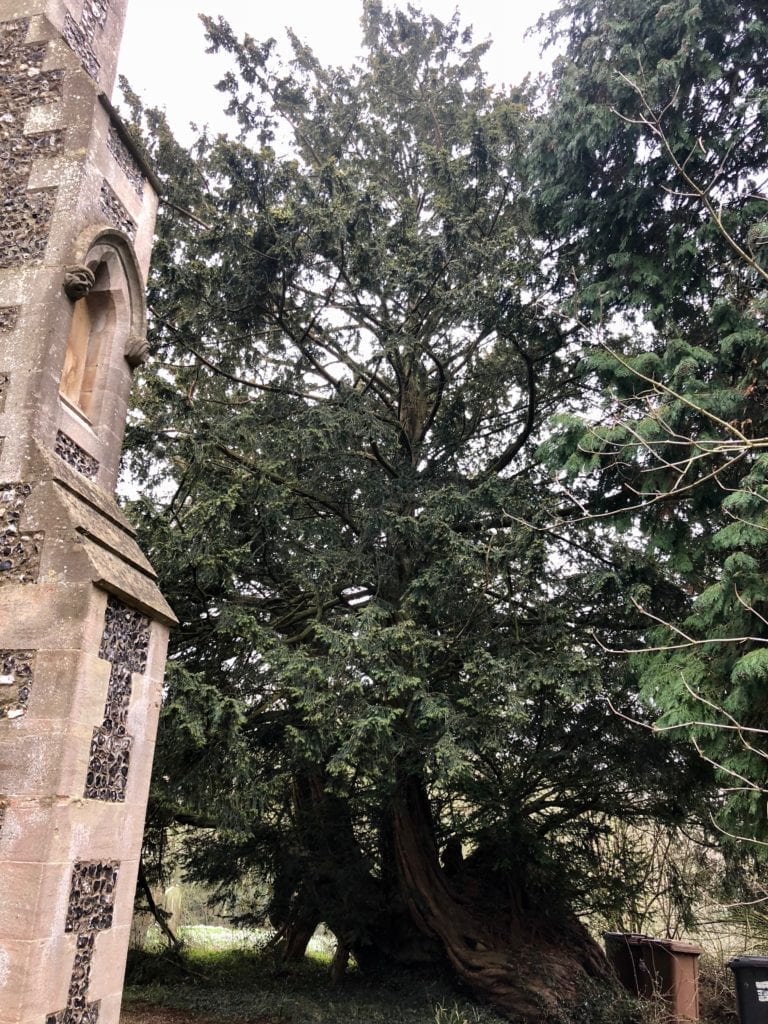Yew tree.
Yew trees are a common sight in church grounds all around the UK. An imposing and beautiful species, it isn’t just a Yew’s aesthetic appeal that makes these trees such a popular choice for graveyards. In fact, in many cases – the Yew trees predate the construction of the church, and it is their links to pre-Christian belief systems which are the very reason that the churches were built in those spots.
Yew trees and Paganism
The woodland trust estimate that in the UK there are at least 500 yew trees on church grounds which are older than the church buildings themselves – thought to be heavily influenced by the role that Yew trees played in the Pagan religion.
Paganism is a broad class of religions that are now considered to be ‘non-mainstream’ – for example, those following a polytheistic system, worshipping multiple gods. Prior to the Roman invasion of Britain, Paganism was common. Pagans observed the Yew’s longevity, and its ability for branches to regenerate into new trees when they fell. The tree became an important symbol of death and resurrection in the Pagan belief system. They were commonly planted at religious sites and burial grounds.
In some cases, swathes of Yews may have been planted at important worship sites. Some distinct groups of pagans, for example, early Druids, considered outdoor worship to be a hugely important part of praising their gods. Although later Druids may have started to use sacred buildings for worship, probably under the influence of Roman culture, early Druids tended to pick sacred sites on elevated ground – to be close to heavenly bodies. In some areas, they actually used Yew plantations to protect the sites from the elements.
As the Christian church grew in popularity in the UK, it was not uncommon for pagan sites of worship to be ‘Christianized’. In some cases, trees that had been worshipped were actually destroyed, in order to discourage the continued worship of tree spirits.
However, many Yew trees still survived, and this is the reason that many are present in modern church grounds.
Although Yew trees are generally very resistant to disease – they can suffer if they are in waterlogged soil.
You may also notice that Yews are not particularly tolerant of bark wounds. In many rural parishes, grazing animals like deer can be a common sight in churchyards. They can quite easily damage the bark of a Yew tree as they rub their antlers. Children or other visitors may also inadvertently damage the bark of a Yew tree as they play or climb. Because Yew trees are not quick to heal, these wounds can actually end up causing extensive damage, even turning portions of the tree brown.
Do you need a reliable, conscientious, high quality and cost efficient tree surgery company? If you live in the Hertfordshire, Bedfordshire, Cambridgeshire or North London area and need help with tree care, please contact us anytime on 07900906249 or info@honeytreesurgeonsltd.co.uk.
We deal with all aspects of tree surgery, pollarding, reduction, removal, as well as tree stump grinding.
Here at Honey Tree Surgeons Ltd we pride ourselves on providing our customers with high quality service and are experts within our industry. We adhere to and conform with industry standard practice and hold industry approved insurances and qualifications.
Our professional and reliable service is here to get your garden looking better than ever. We are always happy to provide you with a written quotation and facilitate any permissions you may require from your local authority.
We come highly recommended by our customers, and you can see an extensive collection of these reviews on our website, www.honeytreesurgeonsltd.co.uk.
So why not take the first step today in transforming your outdoor space. Find out how we can help, on 07900906249, or email on info@honeytreesurgeonsltd.co.uk.
